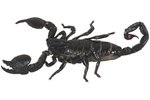
Stingrays present a majestic view as they glide through the water, almost like they're flying. However, most species of stingray spend the majority of their time hiding from predators and waiting on feeding opportunities to present themselves. When they decide to go for a swim, they could become the next tasty meal of a variety of predators.
Why They Hide
Stingrays are opportunistic feeders most of the time, lying in wait for their next meal to happen by. They often eat sea creatures that live on or near the ocean floor, such as crabs, mollusks and shrimp. Hiding gives stingrays the ability to wait until their prey gets close, then scoop up the tasty morsel with little effort. While stingrays are predators in their own right, they are also preyed upon by other predators, including hammerhead sharks, killer whales and large carnivorous fish. Hiding helps protect the stingrays from their predators.
Camouflage
Stingrays typically have mottled skin that looks similar to the colors found on the sea floor. Their colors differ based on species and where they typically live, ranging from a light sand color to a darker, spotted brown for more rocky areas. When they lie flat and still on the bottom of the ocean, their skin provides a helpful camouflage that keeps many predators and prey from spotting them.
Digging
Stingrays don't rely solely on their skin camouflage for protection. They often flip their wings gently as they scoot head-first under the sand, flicking sand over their entire bodies. They don't always cover themselves completely -- although they can -- but the sand adds a second layer of protection to keep them from being spotted by their prey or by creatures who are looking for a tasty ray snack. Because stingrays often rest in warm, shallow waters, many beaches suggest you do the "stingray shuffle" as you wade into the surf, which means you scoot your feet under the top layer of sand to warn buried stingrays of your approach before you accidentally step on one and get stung by his tail.
Defense
Although stingrays are typically passive, they have a long, often venomous barbed tail that they use for self-defense. When threatened, they strike quickly with this flexible tail to ward off predators. The barbed tip is painful when pulled out, discouraging many predators, and the venom can be deadly when injected near a vital organ. Most people stung by rays survive, although the stings can be deadly if the barb pierces an organ such as your heart or if you are sensitive to the venom. The strike site can also become infected from bacteria introduced by the stingray's tail.
References
Photo Credits
-
HUBERT YANN/iStock/Getty Images



